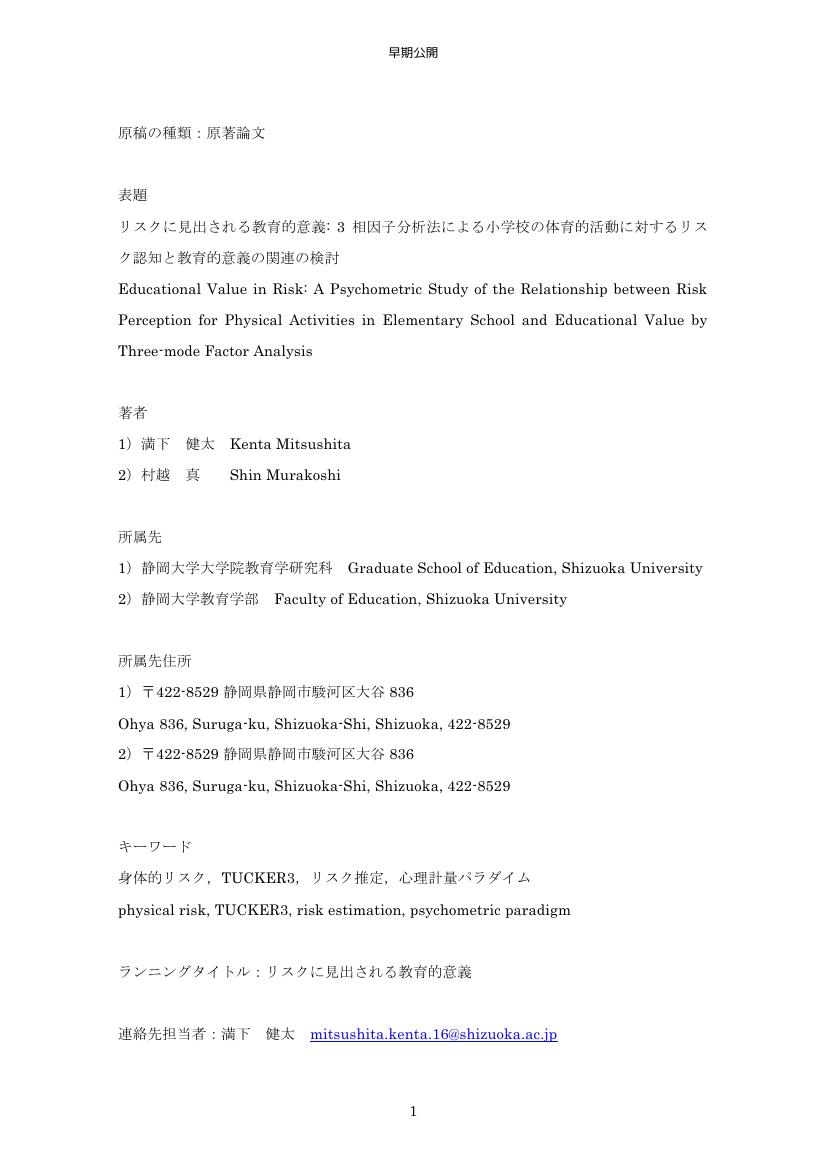- 著者
- 村越 真 満下 健太 小山 真人
- 出版者
- 日本地図学会
- 雑誌
- 地図 (ISSN:00094897)
- 巻号頁・発行日
- vol.58, no.4, pp.1-16, 2020-12-31 (Released:2022-04-19)
- 参考文献数
- 51
This study examined whether students can recognize the risk of natural hazards using topographic or hazard maps, and whether recognition accuracy improves by learning about the relationships between topographic features and hazards from the viewpoint of map literacy. An experiment was conducted with 37 student participants and 3 natural hazard experts. Risk evaluation of sediment-related hazards for 6 sites and floods for 5 sites was required with 7-point scale, both with topographic maps and with hazard maps. The selected sites were either high risk with the risks displayed, high risk without the risks displayed, or low risk, and the participants were randomly assigned either to the experimental group or the control group. The experimental group participants learned about the relationships between topographic features and the risk of natural hazards for 10 minutes, and the control group participants learned about the risk of natural hazards without mention of the relationships. Risk evaluations for the 11 sites were required twice, before and after the learning sessions. As a result, participants were able to evaluate the risk of natural hazards to some extent even with topographic maps, but there were also some sites where they could recognize risks first by using hazard maps. Evaluated risks for many sites declined when the hazard risk was higher but not displayed on the hazard maps, while the experts maintained risk evaluations for such sites. Free descriptions explaining the evaluations revealed that the experimental group acquired knowledge of the relationships between topographic features and risk of natural hazards from the learning sessions, but it did not appear to affect their evaluations of risk. Based on the results, it was argued that autonomous judgments of the risk of natural hazards required knowledge of the relationships between topographic features and risky area of natural hazards as well as the reasons for the relationships and topographic features that should be paid attention to. Theoretical and practical implications for map literacy were also discussed.
- 著者
- 村越 真 満下 健太 小山 真人
- 出版者
- 日本地図学会
- 雑誌
- 地図 = Map : journal of the Japan Cartographies Association (ISSN:00094897)
- 巻号頁・発行日
- vol.58, no.4, pp.1-16, 2020
1 0 0 0 OA 学校の管理下における障害事故の発生状況分析―小学校休憩時間中の事故に対する計量的分析―
- 著者
- 満下 健太 鎌塚 優子 村越 真
- 出版者
- 一般社団法人 日本リスク学会
- 雑誌
- リスク学研究 (ISSN:24358428)
- 巻号頁・発行日
- vol.32, no.3, pp.233-241, 2023-03-15 (Released:2023-03-15)
- 参考文献数
- 32
The aim of this study is to analyze how accidents occur during recess under school management quantitatively with accidents data recorded by Japan Sports Council. In total, 823 accidents data in elementary school from 2005 to 2019 were analyzed by principal component analysis, which extracted five components for interpretation (destruction of glass, eye injury in ball game, being off balance, fall from a bar, and game of tag). Multiple regression analysis revealed the factors (age, sex, type of recess, and place of occurrence) that can affect the component scores on each dimension. Specifically, school grade affected scores of 1st and 2nd component score. Sex affected 2nd and 4th component score. Type of recess affected 1st and 5th component score. The place of occurrence affected each component score by some places. It is considered that this result represents how often each summarized situation occurs proportionately in each category with controlling confounders. From these analyses, some trends about how accidents under school management were indicated. It can be considered that quantitative analysis is one profitable method to analyze data of occurrence status and to understand the current situation about accidents under school management.
- 著者
- 満下 健太 村越 真
- 出版者
- 一般社団法人 日本体育・スポーツ・健康学会
- 雑誌
- 体育学研究 (ISSN:04846710)
- 巻号頁・発行日
- pp.19048, (Released:2020-01-10)
- 被引用文献数
- 1
